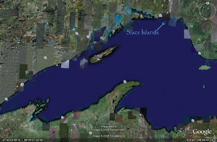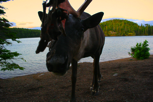

Slate Islands - Lake Superior:
September 2 - 8, 2008
About 450 million years ago:
It was the Ordovician Period. While marine species were undergoing an explosion of evolution, there was little life on land (though there was about to be an explosion of another sort). There were some slimy plants and fungi with possibly some primitive arthropods starting to crawl about (there might have been some worms even earlier).
There was no Lake Superior and the part of North America where it now is, was south of the Equator.
Into this Utopia, streaking along at more than 12 miles/second a large meteorite plunged into the atmosphere. Nearly a mile in diameter it struck the area destined to become the top of Lake Superior with what would have been a catastrophic impact ... if there had been anything to destroy. The colossal explosion left a crater nearly 20 miles in diameter, however the primitive state of life on land raises the question of whether anything heard it.
About a week ago:
It's the Neogene Period. Animals and plants abound in mind-boggling profusion of form and number (though there is evidence we may be entering into another great die-off).
Lake Superior not only exists, but is the largest expanse of fresh water on the globe, half way to the North Pole from the Equator and famous for its cold clear water.The meteorite crater; remnant of a calamity that if it occurred today could end civilization, is unknown to most of the people that live on or near it or to those who pass along its edge on the Trans-Canada Highway. The dramatic central peak of the crater, heavily eroded over Eons, is covered in a chaotic welter of plants, placidly roamed by unconcerned caribou and surrounded by the deep water of the lake. It now appears as an idyllic archipelago seven miles offshore of Terrace Bay, Ontario; the Slate Islands.



